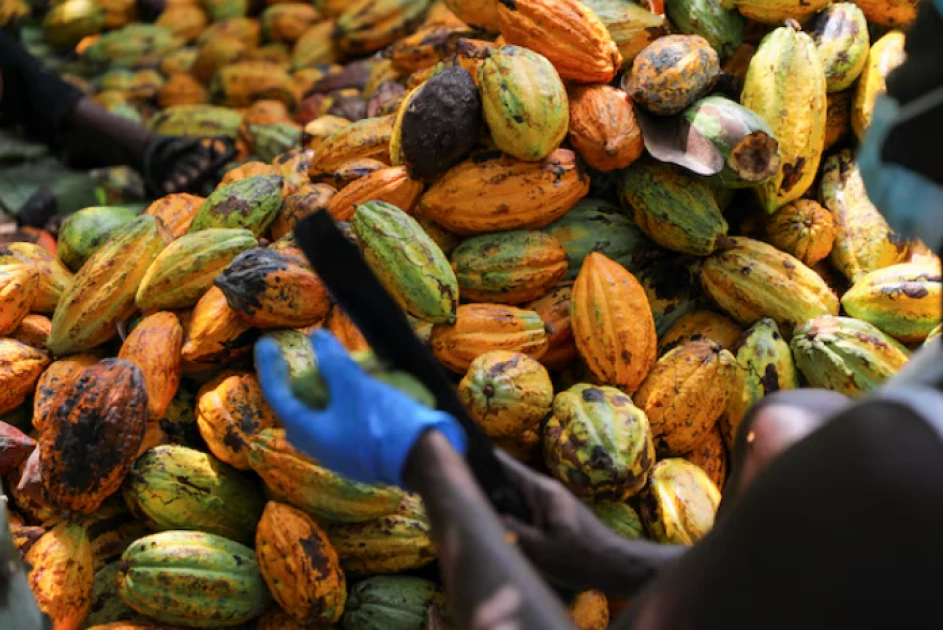Inside Ghana’s cocoa belt: How agroforestry is reviving the land and livelihoods

Labourers process harvested cocoa pods at a farm in Assin Foso, Ghana November 20, 2024. REUTERS/Francis Kokoroko

Audio By Vocalize
“I was hesitant about beekeeping on our farm because of the risks it posed to the safety of our children who accompany us there. But we were assured that protective clothing would be provided to make beekeeping safe. It was the right decision… Today, our land is part of a growing agroforestry movement in Ghana’s cocoa belt.”
Between beekeeping, tree planting, and cocoa cultivation,
Ghanaian couple Alex and Georgina Nyarco have drawn the outlines of a new life
built on what is known as agroforestry
— a deliberate practice that combines trees with crops, livestock, or bees.
By preserving and planting trees alongside cocoa, farmers in
Ghana are not only rehabilitating degraded lands but also creating more
resilient farms and new sources of income — a living example highlighted in a
report by the World Resources Institute (WRI).
When Alex and Georgina Nyarco first heard about beekeeping on their cocoa farm,
they were skeptical — according to the Institute’s report — wondering: Could bees really help them
earn a steady income? Yet they set their doubts aside and decided
to work with Goshen Global Vision,
a non-profit organization that helps small farmers build sustainable
livelihoods.
With training and a modest investment, the couple installed
eight beehives on their land and began planting and protecting native trees.
While many farmers clear natural vegetation to make room for more cocoa trees,
the environmental organization affirms that bees need trees for food and
shelter, and that the shade they provide can help cocoa trees thrive.
Indeed, after a year, the beehives brought much more than
honey to the small cocoa farm. Today, Alex and Georgina earn additional income
from harvesting and selling honey from their hives. The bees also help
pollinate the cocoa trees, while the farm’s trees enrich the soil — all of
which has increased cocoa yields and boosted the couple’s income, according to
the WRI report published in mid-October.
Ghana is the world’s second-largest cocoa exporter, generating
revenues exceeding $2.2 billion annually. To ensure continued success, the
country has adopted a forest conservation policy, for without the trees that
hold the soil in place, wind and rain wash away the nutrient-rich topsoil,
leading to reduced crop yields.
For example, in September
2024, the United
Arab Emirates and Ghana announced a $30 million partnership
targeting six investment areas, including biodiversity, reforestation, and
agroecology — sectors that deliver multiple benefits in climate action,
biodiversity, and community development, according to the Emirates News Agency (WAM).
Through this partnership, the UAE sought to support Ghana’s
“Resilient Plan” for nature and climate, within the enhanced initiative to
reduce emissions from deforestation.
The world’s governments had backed the “UAE Consensus” reached at COP28, setting a goal of ending
deforestation by 2030. The UAE and its partners succeeded in mobilizing over $2
billion to finance nature and climate-related projects and programs.
It is worth noting that Ghana and the UAE are members of the Forest and Climate Leaders’ Partnership,
a mechanism for coordinating public and private investments in forest protection
and climate action, according to WAM.
Today, the Nyarco family — and many others like them — are proving that the
prosperity of the cocoa industry need not come at the expense of forests. Once
a secondary idea, agroforestry has now become central to Goshen Global Vision’s work in
Ghana’s western region, as noted by the World Resources Institute report.
The organization told the Institute that it trains local
farmers in tree planting, beehive maintenance, and honey collection, with the
primary goal of turning restored trees into income-generating assets.
Goshen Global Vision is among several organizations
working with the WRI’s “Local
Restoration Accelerator” initiative. Its funding arm, TerraFund, has invested in 15
non-profit organizations and five local companies in Ghana’s cocoa belt.
According to the Institute’s report: “So far, these
organizations have planted 4.1 million trees, created 6,400 jobs, and are
restoring 9,300 hectares of land. Collectively, they are moving closer to
Ghana’s national goal of restoring two million hectares of degraded land by
2030 under the African Forest Landscape Restoration Initiative.”
With support from the World
Bank, Ghana has also become one of Africa’s leaders in reducing
emissions from deforestation and degradation, and among the first countries
globally to receive carbon payments from the Bank for reducing emissions tied
to cocoa-driven deforestation.
A report published on the World Bank’s website in April stated that
investments in the forestry sector have reached more than 130,000
beneficiaries, building significant advisory capacity in sustainable forest
management in the country’s north — its most climate-sensitive and poorest
region.
Finally, with additional World Bank support of $20 million, Ghana’s
government is implementing multiple initiatives in the natural resources sector
to achieve inclusive and sustainable growth — foremost among them encouraging
environmentally sustainable cocoa production and providing additional
livelihoods for forest and rural communities.


Leave a Comment